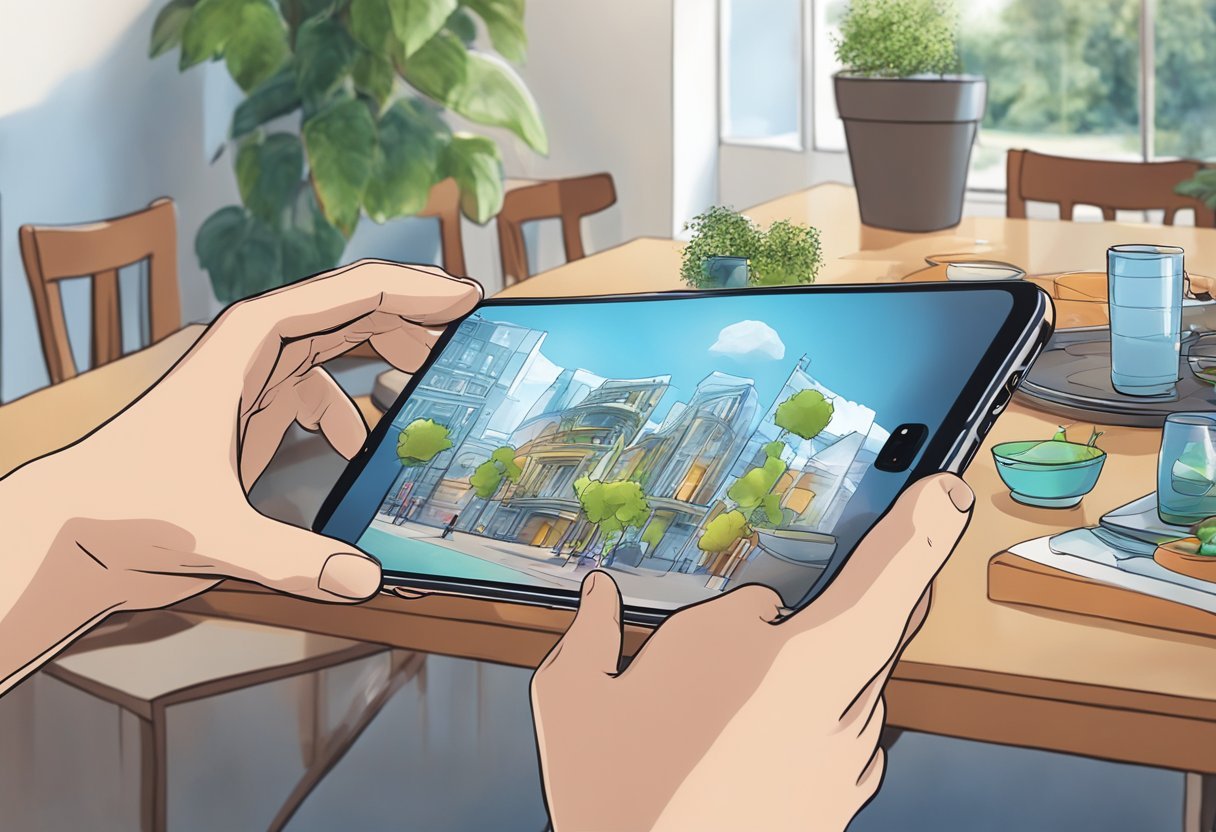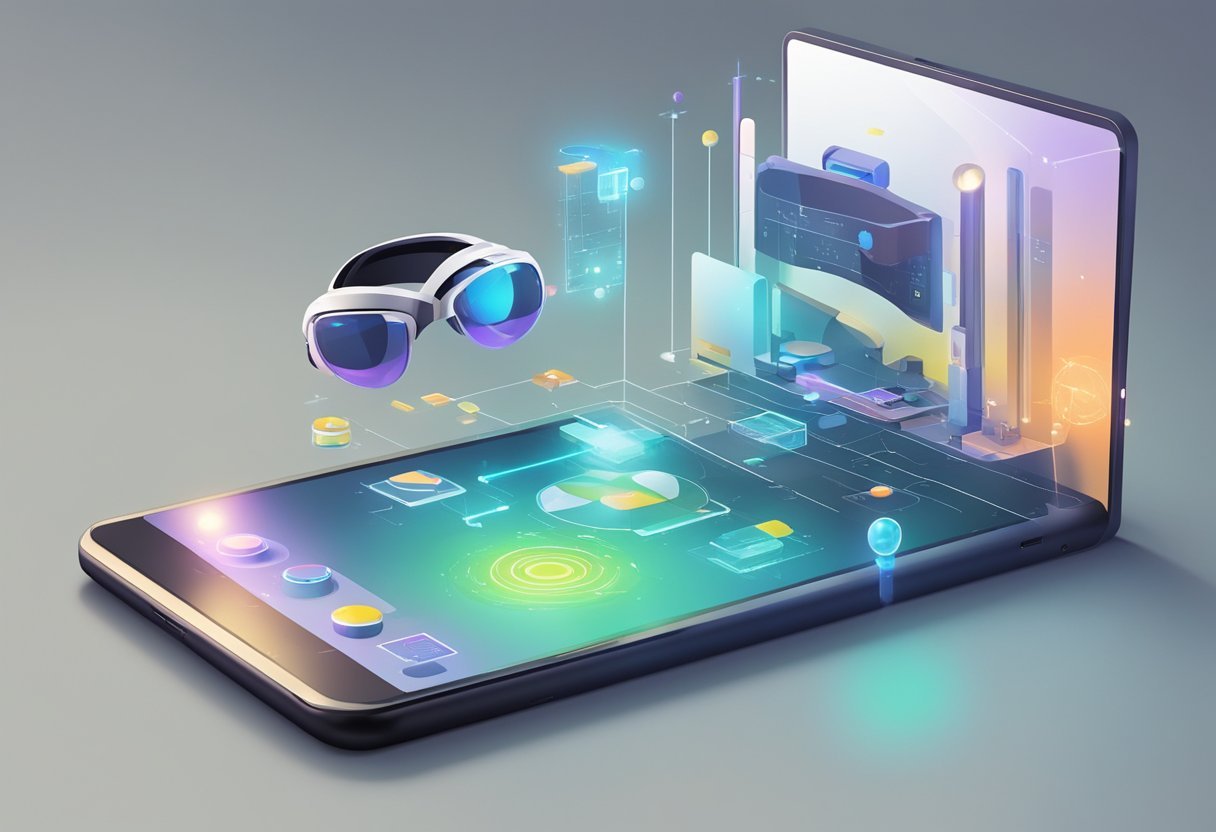Augmented Reality (AR) is a technology that has taken the world by storm, and it has been used in many different industries. Augmented Reality applications (AR apps) are software applications that integrate digital visual content into the user’s real-world environment. AR software is used for training, work, and consumer applications in many industries, including healthcare, public safety, gas and oil, tourism, and marketing.
AR is different from Virtual Reality (VR), which creates a totally artificial environment. AR users experience a real-world environment with generated perceptual information overlaid on top of it. AR is a relatively new technology that has gained increasing popularity in recent years. It enables users to interact with digital content in a physical environment in real-time, offering an enhanced experience.
Understanding Augmented Reality is important for users who want to experience the technology and developers who want to create AR apps. Augmented Reality is a technology that combines virtual reality with the real world in the form of live video imagery that is digitally enhanced with computer-generated graphics. AR can be experienced through headsets that people wear and through displays on mobile devices. Handheld AR Equipment is convenient to use.
Key Takeaways
- Augmented Reality (AR) is a technology that integrates digital visual content into the user’s real-world environment.
- AR is different from Virtual Reality (VR) as it generates perceptual information overlaid on top of the real world.
- AR can be experienced through headsets that people wear and through displays on mobile devices.
Understanding Augmented Reality
Augmented Reality (AR) is a technology that superimposes digital information such as images, videos, and sounds on the real world. It enhances the user’s perception of reality by augmenting the real world with digital information. AR is different from Virtual Reality (VR) in that it does not create a completely new environment but instead augments the existing environment with digital information.
AR vs VR: Comparing Technologies
AR and VR are both immersive technologies that provide users with an interactive experience. However, the two technologies differ in their approach to creating this experience. VR creates a completely new environment, while AR augments the existing environment with digital information. VR is usually experienced through a headset, while AR is experienced through a device such as a smartphone or tablet.
Core Components of AR
The core components of AR include a display, camera, and software. The display is used to present the digital information to the user, while the camera is used to capture the real-world environment. The software is responsible for processing the camera feed and overlaying the digital information on top of it.
AR software uses computer vision algorithms to identify and track the real-world environment. It then uses this information to overlay digital information on top of the real-world environment. The digital information can be in the form of images, videos, or sounds. AR can be used in a variety of applications, including gaming, education, and marketing. It has the potential to revolutionize the way we interact with the world around us by augmenting our perception of reality.
How AR Works

Augmented Reality (AR) works by using a combination of cameras, sensors, software, and display technologies to overlay digital information onto the real world in real-time. AR technology recognizes markers or objects in the user’s environment and then augments them with digital content, such as images, text, or 3D models.
The Role of Cameras and Sensors
Cameras and sensors play a crucial role in AR technology. They provide the necessary data about the user’s environment, which is then processed by the AR engine. This data includes information about the user’s location, movement, and orientation, as well as the position and characteristics of objects in the environment. The camera captures the image of the real world, while the sensors provide additional information such as the user’s movement and orientation.
Software and AR Engines
AR software and engines are responsible for processing the data captured by the cameras and sensors and overlaying digital information onto the real world. The software uses advanced algorithms to recognize markers or objects in the user’s environment and then overlays digital content onto them. The AR engine also takes into account the user’s movement and orientation to ensure that the digital content is properly aligned with the real world.
Display Technologies in AR
Display technologies play a crucial role in AR technology as they are responsible for overlaying digital content onto the real world. AR displays can be either head-mounted displays (HMDs) or handheld devices such as smartphones or tablets. HMDs provide a more immersive experience as they completely cover the user’s field of view. Handheld devices, on the other hand, provide a more practical and accessible solution for everyday use.
AR technology works by using a combination of cameras, sensors, software, and display technologies to overlay digital information onto the real world in real-time. The technology recognizes markers or objects in the user’s environment and then augments them with digital content, such as images, text, or 3D models.
Applications of AR
AR technology has a wide range of applications in various fields, including gaming, education, healthcare, and industries. AR apps have been developed to provide an interactive and engaging experience for users. The following subsections will discuss some of the most common applications of AR.
AR in Gaming and Entertainment
AR has revolutionized the gaming industry by providing an immersive experience for players. AR games use the real-world environment as a backdrop and add virtual elements to it, creating a mixed reality experience. The popular mobile game, Pokemon Go, is a prime example of an AR game that has gained widespread popularity.
AR technology has also been used in the entertainment industry to create interactive experiences for audiences. For example, AR has been used in concerts and live events to enhance the experience for attendees.
Educational Uses of AR
AR technology has also been used in education to create an interactive and engaging learning environment. AR apps have been developed to provide students with a hands-on learning experience. For example, AR apps have been developed to teach anatomy, allowing students to visualize and interact with 3D models of the human body. AR has also been used in museums and galleries to provide visitors with an interactive and informative experience.
AR in Healthcare
AR technology has been used in healthcare to improve patient outcomes and enhance medical training. AR apps have been developed to assist with surgical procedures, allowing surgeons to visualize and plan surgeries in 3D. AR has also been used to provide medical training for healthcare professionals, allowing them to practice procedures in a safe and controlled environment.
Commercial and Industrial AR Applications
AR technology has been used in various industries to improve efficiency and productivity. AR apps have been developed to provide workers with real-time information and data, allowing them to make informed decisions. For example, AR has been used in manufacturing to visualize data in real-time, enabling workers to make timely data-driven decisions. AR has also been used in public safety to provide first responders with real-time information, allowing them to respond more effectively to emergencies.
AR technology has a wide range of applications in various fields, including gaming, education, healthcare, and industries. AR apps have been developed to provide an interactive and engaging experience for users, and the technology has the potential to revolutionize the way we learn, work, and play.
AR Hardware and Devices

AR technology is highly dependent on the hardware and devices used to create and display the augmented reality experience. In this section, we will explore the different types of AR hardware and devices available today.
Smartphones and Mobile AR
Smartphones are the most common devices used for mobile AR applications. They have built-in cameras, sensors, and processors that enable them to track the user’s movements and display AR content in real-time. The most popular mobile AR platforms are Android and iOS, which have their own AR development kits (ARCore for Android and ARKit for iOS).
Head-Mounted Displays and Glasses
Head-mounted displays (HMDs) and smart glasses are wearable devices that allow users to experience AR hands-free. They usually come with built-in cameras, sensors, and displays that project AR content onto the user’s field of view. Some popular AR headsets include Microsoft HoloLens, Magic Leap One, and Google Glass.
Emerging AR Wearables
As AR technology continues to evolve, new types of wearables are emerging that promise to enhance the AR experience even further. These include AR contact lenses, AR smartwatches, and AR earbuds. While these technologies are still in the early stages of development, they have the potential to revolutionize the way we interact with the world around us.
AR hardware and devices play a crucial role in creating and displaying augmented reality experiences. From smartphones to HMDs and emerging wearables, there is a wide range of AR devices available today that cater to different needs and preferences. As AR technology continues to evolve, we can expect to see even more exciting developments in the world of AR hardware and devices.
The Future of Augmented Reality

Augmented Reality (AR) is an immersive technology that blends digital content into the real world. AR has come a long way since its inception and has made significant progress in delivering realistic and interactive experiences. The future of AR is exciting, and it is expected to revolutionize the way people interact with technology.
One of the most significant developments in AR is the concept of the Metaverse, which is a virtual world that is entirely immersive and realistic. The Metaverse is expected to be the next evolution of the internet, where people can interact with each other and the digital world in a more natural and intuitive way.
AR technology is also becoming more accessible to the masses due to the increasing computing power of devices and the development of AR software development kits (SDKs). These SDKs allow developers to create AR applications for various platforms, making it easier for businesses to incorporate AR into their products and services.
Microsoft’s HoloLens is a prime example of how AR can be used to enhance the user’s experience. The HoloLens is a wearable device that allows users to interact with digital content in their real-world environment. The HoloLens has been used in various industries, including healthcare, manufacturing, and education.
Another exciting development in AR is the smart contact lens, which is a lens that can display digital content directly onto the user’s eye. The smart contact lens has the potential to revolutionize the way people interact with technology, making it more seamless and intuitive.
The future of AR is bright, and it is expected to deliver immersive and realistic experiences that will change the way people interact with technology. The increasing accessibility of AR technology and the development of new devices and SDKs will make it easier for businesses to incorporate AR into their products and services, delivering more value to their customers.
Frequently Asked Questions
How do augmented reality applications enhance user experience?
Augmented reality applications enhance user experience by overlaying digital information onto the real world. This allows users to interact with the environment in new and exciting ways. AR apps can provide users with information about their surroundings, create interactive experiences, and add a new layer of engagement to real-world activities.
What are some common uses of AR in educational settings?
AR technology has many potential uses in educational settings. For example, AR apps can be used to create interactive textbooks, enhance museum exhibits, and provide students with immersive learning experiences. AR can also be used to teach complex concepts in a more engaging and interactive way.
In what ways do AR apps differ from VR technology?
While both AR and VR technologies are used to create immersive experiences, they differ in several ways. AR technology overlays digital information onto the real world, while VR technology creates a completely digital environment. AR technology is typically used to enhance real-world experiences, while VR technology is used to create entirely new ones.
Can you provide examples of AR technology in everyday use?
AR technology is becoming increasingly common in everyday life. For example, Snapchat filters and Pokemon Go are both popular AR apps. AR technology is also used in retail to allow customers to try on virtual clothing and in navigation apps to provide users with directions in real time.
What functionalities do AR apps typically provide on Android devices?
AR apps on Android devices typically provide users with a range of functionalities, including object recognition, image tracking, and 3D modeling. These functionalities allow AR apps to overlay digital information onto the real world and create immersive experiences for users.
How is AR integrated into mobile devices like those from Samsung?
AR is integrated into mobile devices like those from Samsung through the use of software development kits (SDKs). SDKs provide developers with the tools and resources they need to create AR apps that can be used on Samsung devices. Samsung also offers its own AR platform, called ARCore, which allows developers to create AR apps specifically for Samsung devices.




